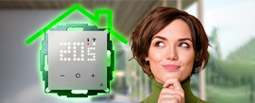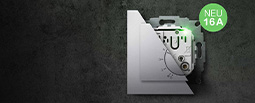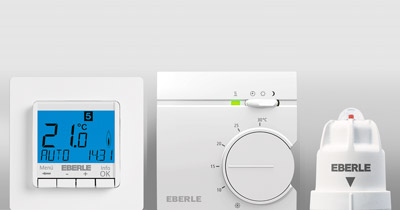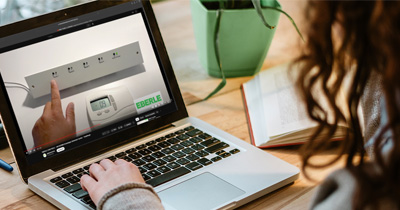Yes, you just have to make sure that three wires are available. An electronic room thermostat also needs the neutral conductor (blue).
Basically you need three wires, including for mechanical room thermostats, because of the thermal feedback. We therefore recommend the use of a sheathed cable NYM-J 5x1.5 mm² (brown, black, grey, blue, green/yellow).
In the case of a mechanical room thermostat with thermal feedback, an additional heating resistor is installed. This simulates a temperature increase in the heating process and causes the controller to switch off in time, such a thermal feedback is installed in all EBERLE electromechanical room thermostats.
Mechanical and digital room thermostats have only two switching states, either on or off. With pulse width modulation, an actuator is switched on and off variably within a predefined cycle time.
No, you can combine room thermostats and actuators from any manufacturer. However, the same operating voltage (230V or 24V) and the "normally closed or open" characteristic of the actuators are important.
The optimum place for a room thermostat is at a height of 1.50 m in a freely accessible location protected from draughts, additional heat sources such as lamps, sunlight and not directly above radiators. It must be ensured that the room thermostat is not exposed to any external heating or cooling, even at the rear, e.g. in the case of draughts or risers in hollow walls.
A room thermostat with change-over contact has two switching outputs, one for heating and one for cooling. Here, “either or” applies, they only work both together conditionally. If your actuator is only connected to the heating output, you can replace it with a room thermostat with NC contact. A room thermostat with change-over contact can also be used for normally closed or normally open actuators.
If wood is also used for heating, the heat in the room increases, the room thermostat closes the actuator and the floor cools down. To prevent this, you need a room thermostat with limiter function, such as the FIT 3L controller or the UTE 2800-L with sensor connection and option of setting a minimum floor temperature. The floor sensor installed in the screed activates the room thermostat as soon as the temperature falls below the set floor temperature, even if the room temperature does not require this.
An electronic room thermostat with display shows the current room temperature and the switching status, the desired temperature can be set to the exact degree, unlike analog room thermostats. Useful functions such as valve protection or operation lock can be conveniently activated in the menu.
These are merely different names for the same thing; both devices measure the current room temperature and compare it with the desired setpoint temperature. If there is a difference, the heating is switched on or off, e.g. via connected actuators.
With on/off control, the switching output is kept active until the desired (set) setpoint is reached. The switching on is slightly delayed by a hysteresis so that there is no fluttering of the switching output at the setpoint.
Controllers with relay output are commonly used, they have the advantage that you can switch large current loads. Triacs are electronic switching elements which, in contrast to relays, switch silently.
A potential-free contact is usually a relay which, unlike a "standard" controller, does not output a switching power, but opens or closes a contact without power. To use this, you must connect the supply voltage of your load to the contact.
CO stands for change-over contact which, when assigned/used, reverses the function of the room thermostat output and switches it to cooling mode. When 0V is applied, the controller is in heating mode and at 230V it is in cooling mode, provided that your system is designed for heating and cooling.
Individual room control is required by law
For example, the current German Energy Saving Ordinance (EnEV 2014) states that hot water heating systems must be equipped with room temperature control that operates on a room-by-room basis. While many homeowners are required to retrofit this technology, there are exceptions.
As a specialist wholesaler yes, as an installer or end customer this is not possible directly, but as an installer you can find the right wholesaler via the ELBRIDGE link on our website and submit your product selection directly. The device may only be opened by a qualified electrician and installed in accordance with the circuit diagram on the device or these instructions. The existing safety regulations must be observed.
In order to integrate additional functions such as pump logic, heating/cooling switchover or dew point detection, a terminal strip is recommended. A clean wiring, LED indicators, as well as a fine-wire fuse allow a professional setup, which facilitates troubleshooting if necessary.
The floor sensor is used to prevent overheating of the floor, be it to protect expensive floors or feet.
In Germany, flush-mounted boxes normally have a depth of 50 mm. This is sufficient for our thermostats. In older households, the flush-mounted boxes are sometimes only 40 mm deep. Even today, there are still so-called flat boxes, which have a depth of only 35 mm.
This is the inductive load.















